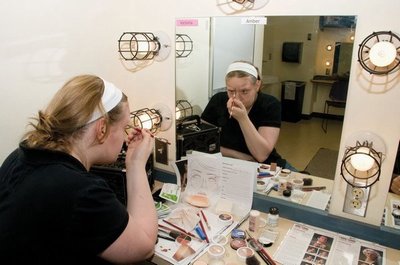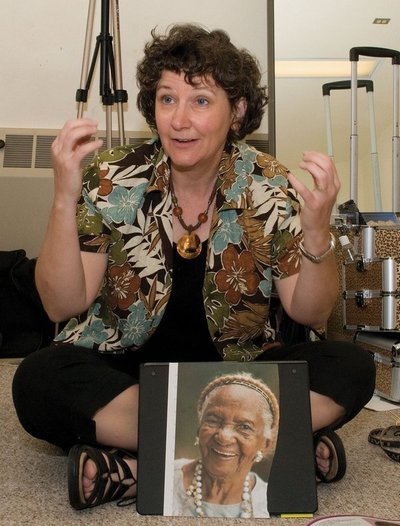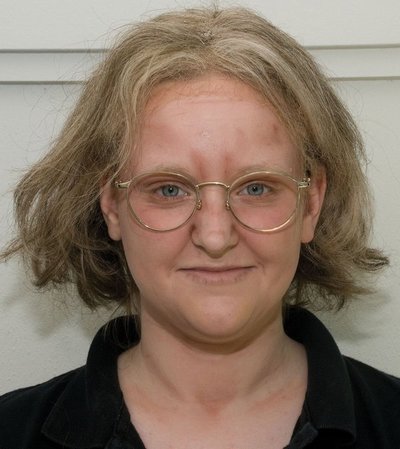July 10, 2008
Making faces: Theatrical makeup class draws majors and nonmajors alike
Every summer quarter, the School of Drama opens up its course in theatrical makeup to nonmajors. And though what they learn probably won’t help them in their careers, they respond — filling the class in hours.
Take Amber Uttecht, for example. She’s a business major in the entrepreneurship program who signed up for the class mainly because she thought it would be fun, though she added, “I thought it might give me some insight on color contrast for the products I design and sell.”
Uttecht was serving as teacher Josie Gardner’s model last week as the class learned about old age makeup. Before the demonstration, the students sat in a circle on the Penthouse Theatre’s dressing room floor while Gardner — who is the drama school’s costume shop supervisor — gave a brief lecture on what happens to the face as a person ages, using photos to illustrate her points. Then she began her work on Uttecht — applying a pale base makeup, then asking Uttecht to raise her forehead, squint her eyes and otherwise crinkle her smooth young face so that lines could be drawn where the forced wrinkles appeared. The lines were followed by first shading, then highlighting. Gardner used a stipple sponge over it all to make the skin appear less smooth.
Then it was the students’ turn. They moved to their assigned mirrors with a worksheet of instructions in hand, ready to begin their own instant aging process.
And that’s pretty much how the class goes, Gardner said, with each session devoted to a different project. After an introductory class in which students learn about the anatomy of the face, they get a lesson on corrective makeup — how to enhance their own features for a role not far from their own identity. Old age makeup is the next assignment, and students also learn about facial hair, baldness, crepe hair and wigs.
The next class is for the “likeness” assignment. Students choose a well-known person who looks at least a little like them, then make themselves up to look like as much like that person as possible. After that, things get a little wilder — with assignments on animal/fantasy makeup and horror/trauma makeup. The class finishes with assignments on stylized Kabuki makeup and historical period makeup.
“Part of the class is getting students used to the idea that this is not just like putting on your Halloween makeup,” Gardner said. “I really want them to think about what they’re doing and how they’re doing it and what effect they’re going to get.”
Gardner always takes photos of the students after they complete each assignment and posts them on the class Web site. Photos from the spring class show students made up like Marilyn Monroe, Liza Minnelli and Elizabeth Taylor for the likeness class, while the fantasy/animal class featured Batman, a king from a deck of cards and a bird with red feathers and a black bill.
Gardner said the students’ appearance can sometimes get them in trouble if they choose not to wash off the makeup when class is over. Last year, for example, one student boarded a bus wearing trauma makeup, and the bus driver was so unnerved that he insisted she get off the bus while he called the police.
But the trauma makeup — which involves fake bruises, black eyes, bullet holes and other assorted wounds — can be useful, as well. Gardner consulted with the University’s emergency team when they were staging simulations involving the rescue of disaster victims — teaching the team how to make the injuries look real.
The class isn’t heavy on research, but Gardner does ask the students to study a particular time period for the historical assignment, then — besides applying makeup for that time period — they write a paper and share the information with the class.
Although the class is not required for drama majors, learning about makeup is a good idea for anyone aspiring to be an actor, Gardner said, because actors are often expected to do their own makeup. Her own specialty is costumes, but she said a makeup class was part of her graduate level costuming program.
“Makeup really completes a costume and you have to get used to looking at that,” she said. “So if you have a beautiful period costume and the actor is wearing contemporary makeup, your director won’t be happy. It’s not a complete picture unless they’re complete from top to toe.”
It is possible to specialize in makeup through certificate programs, and a few of Gardner’s students have gone on to such programs — including two out of her first class 11 years ago who have had careers in the field.
But for most students, like Rayan Farag, the class is simply a kick. “I’m majoring in biochemistry and this is my first quarter here,” said Farag, who loaded up on science in community college before enrolling at the UW. “I wanted to start off with something fun.”
Gardner just hopes her students gain an appreciation for the art that goes into theatrical makeup.
“When students go to movies after they take my class, I want them to look at people very differently,” she said. “I want them to have a different view of what goes on on that screen and how much thinking goes into it, how much planning goes into it. It’s not just a pretty face.”






